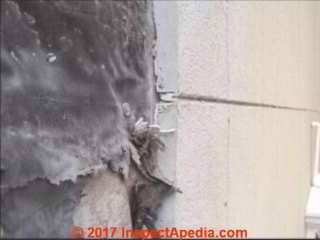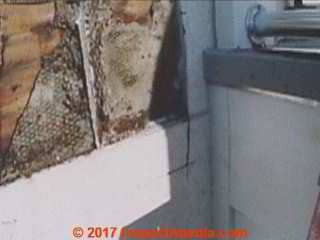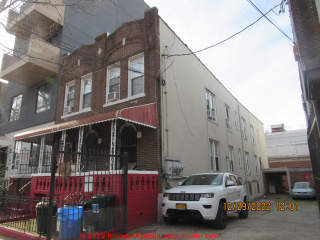 Hard-Coat Stucco Installation, Inspection, Repair
Hard-Coat Stucco Installation, Inspection, Repair
Stucco cracks, leaks at control joints, standards
- POST a QUESTION or COMMENT about stucco wall coatings: types, installation, cracks, diagnosis, & repair
Hard-coat traditional stucco inspection, troubleshooting, repair & standards.
Here, using a field report of leaks at horizontal control joints in a hard-coat stucco wall system, we describe the inspection, diagnosis, repair, and proper compared with improper installation of traditional stucco building wall surfacing systems. The discussion poses questions about the causes of leaks in stucco walls and also questions the reliability of stucco wall system standards.
Ron McClure discusses the hard coat stucco cracks, control joints, drainage, barriers and weep screeds.
InspectAPedia tolerates no conflicts of interest. We have no relationship with advertisers, products, or services discussed at this website.
- Daniel Friedman, Publisher/Editor/Author - See WHO ARE WE?
Hard Coat Stucco Cracking - a view from the field
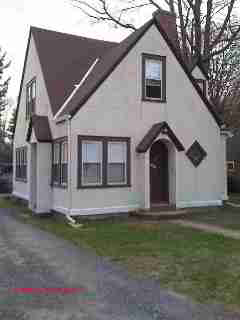
Ron McClure, January 2017, updated 2023
The Multicoat Hard Coat Stucco System is an Exterior Stucco System and is comprised of a weather-resistant barrier, lath, base coat, and a finish coat. The Multicoat Hard Coat Stucco System are applied directly to a structure at the construction site, or may be applied to prefabricated panels. - BuildSite, www.buildsite.com, from Multicoat Hard Coat Stucco System, cited atReferences or Citations
OPINION: Information provided in this article comes solely from what I call "real world" conditions. These comments and opinions are the result of the inspection of thousands of stucco applications and they include only little consideration of building codes nor of ASTM standards for stucco installations.
This is not because I believe in all cases these codes or standards are incorrect.
Rather, I find actual on-site field conditions give rise to a different point of view than what I see in building codes and standards The following opinion s are examples of my findings.
Stucco cracks are without a doubt the most asked about questions associated to stucco systems. Understanding that and without an in-depth study on the matter, the following information hopefully will answer your questions and give you information typically not provided in most home inspection reports.
[Click to enlarge any image]
Although cracks are the result of many different factors, some natural and some the result of construction or application errors, typically they are cosmetic only, common in hard coat stucco and not associated to damaging moisture infiltration. In some cases cracks can be of grave concern and need to be understood so that proper modifications and/or repairs can be made.
ASTM Standards for Stucco Systems
Unfortunately due to building codes that adopt ASTM (The American Society for Testing and Materials) standards there are some conditions associated to cracks that can be difficult to avoid.
Specifically, ASTM standards that relate to stucco systems, both ASTM C1063 & C926, do not appear to contemplate real world conditions and are therefore, in my opinion, incorrect and should not be used in the application of stucco systems. I believe through a better understanding of these problematic code requirements one can provide for better application and repairs details.
Opinion on Plaster Wall Drainage Systems
ASTM C926: Under A2. Design Conditions section A2.2 establishes design requirements for Drainage Behind Exterior Plaster. In this section it provides for the following requirement: "a drip screed and through-wall flashing or weep holes or other effective means to drain away any water that may get behind the plaster should be provided.”
The problem with this requirement is it suggest water will drain behind the stucco, a condition of which I have never seen.
In every case that I have found where water has entered behind the stucco, long before it ever gets (drains) to the base of the wall, the water has degraded the barrier and entered into the structure.
Plainly put there is no such thing as Drainage Behind Exterior Plaster and I do not believe anyone should ever consider it as part of a functional design element of a stucco system.
Opinion on Control Joints in Plaster Systems
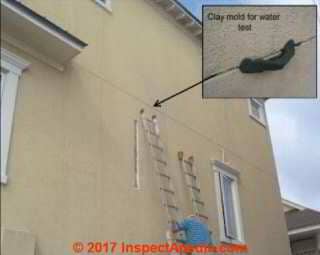
ASTM C1063: Installation of Lathing and Furring to Receive Interior and Exterior Portland Cement-Based Plaster section #7.11.4.1 defines the Standard for Installation of Control (expansion and contraction) Joints.
Looking at it from an engineering perspective, installation of control joints may sound quite logical, but my field examinations reveal that in the real world control joints do not eliminate field cracks. In fact, cracks at control joints are often the cause or source of very aggressive and damaging moisture infiltration.
One of the major problems I have with control joints like the one shown in the photograph here is that if the intent of a control joint is to serve as a design point for stress relief then doesn't it make since that relief would be in the control joint itself. If that is the case then the question begs to be asked:
Is a crack in a control joint better or worse than a crack in the stucco panel itself?
The answer is, it depends.
Due to the shape of the control joint, if a crack on a horizontal joint is on its upper side it normally would be of little concern (typical of general field cracks) although if the crack is on the lower side of the control joint it can result of excessive water infiltration.
The photograph above illustrates the stucco control joint and what appears to be a very small crack at the lower side of the joint. The clay mold in the photograph inset at upper right is used for the purpose of testing the crack for infiltration.
The two photographs below show the entry point of the water in this stucco covered wall.
Note the following important findings:
- The point of water entry is the lower side of the control joint.
- Two layers of house wrap failed to keep water from entering into the structures substrate.
Editor's note: house wrap can prevent water intrusion if it is properly installed, lapped, taped, and sealed around openings and penetrations, but it will not prevent water intrusion if it is cut, torn, improperly placed, or left open around windows,doors, or other penetrations in the exterior walls. See Steve Bliss's comments on housewrap installation
at HOUSEWRAP AIR & VAPOR BARRIERS
Moisture Damage from Leaks in Stucco Walls
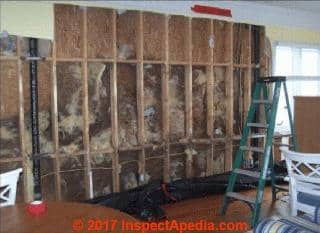
This photograph shown the interior side of the same building wall wall with the drywall and insulation removed to show black stains, probably mold contamination from leaks into the wall cavity.
Although I do not believe the picture shown above of a horizontal control joint on the exterior of a building needs an explanation, the evidence given here demonstrates the potential problems associated with control joints: water infiltrating behind the stucco coating was not able to drain behind the stucco. [Instead it entered the wall cavity.]
In an attempt to determine the cause of some moisture related damage to some interior drywall we conducted some water tests at different points of the exterior wall and discovered the source of the water appeared to be at the control joints within the stucco system.
The photograph just above shows an area where the stucco was removed to expose the substructure and barrier.
 The photograph of a cut-out section of the hard-coat stucco wall coating shows the back side of a rectangular panel of stucco that we cut out of this leaky wall, including sections above and below the horizontal control joint.
The photograph of a cut-out section of the hard-coat stucco wall coating shows the back side of a rectangular panel of stucco that we cut out of this leaky wall, including sections above and below the horizontal control joint.
The horizontal line dividing the 2 stucco panels is the horizontal control joint itself.
The panel is positioned as it was on the wall with the upper area of the cutout section being the upper portion of the panel when it was on the wall, and the lower area in the photo being the lower panel when it was on the wall.
The water-stained area on the back of this stucco cutout section was below the control joint.
Note the following:
- The upper panel has not been exposed to moisture related rust in the lath and staples.
- The lower panel, just below the control joint, has been exposed to moisture infiltration and related rust to both lath and staples.
Follow-up Questions about Leaks at Horizontal Control Joints in Hard-Coat Stucco Wall Systems
Editor's opinion:
McClure's photographs and comments illustrate serious leakage into a wood-framed wall structure. Leaks occurred from the building exterior, sending wind-driven rain or water run-down on the exterior wall through the horizontal control joint and into the building's wood-framed exterior wall cavity.
Leaks wet the interior side of the exterior wall sheathing, the building wall insulation, and probably the cavity-side of drywall on the wall interior surface. There may also have been an additional issue of mold contamination.
Since it's apparent that not all control joints in all stucco walls leak, some questions and their answers might help us understand this stucco leak failure more thoroughly.
The wall leaks described above might have occurred through a combination of physical causes, design questions, construction errors, and questionable building standards:
- Openings through the wall stucco coating
at the horizontal control joint.
A closer look, including close-up photos and photos of the wall cross section in a stereo microscope might give a better understanding of why the horizontal control joint leaked at this location and not at others.
Were there failures in the sealant used in the control joint? Was it the proper sealant, properly applied on clean dry surfaces?
Similar leak issues are discussed at SIDING EIFS WALL LEAK POINTS - Absence of a functional drain system behind the hard-coat stucco
that might have given an easy path for water to exit at the wall bottom or at a lower, flashed control joint as is used in some veneer systems with weep openings.
Was this hard-coat stucco wall system designed with a purported drain system or was there none even attempted?
What is the age of this leaky stucco wall?
Where is this building located and in what climate?
See STUCCO WALL WEEP SCREED DRAINAGE - Defects in the building's house-wrap
installed behind the stucco that let water penetrate the house wrap.
What was the house-wrap material?
Were there tears, cuts, or overlap-direction errors in the housewrap?
Was the house wrap taped or sealed around windows and doors?
Did leaks occur in those locations - perhaps at the horizontal joints over windows and doors or were leaks found only at the control joints in this stucco wall?
See HOUSEWRAP INSTALLATION DETAILS - Are some building standards unrealistic
and do they serve more to protect manufacturers than consumers?
If a building standard is so demanding that it is unlikely that contractors, in the field, will ever comply with all of of the standards provisions, and if compliance with the standard is absolutely essential for a successful product installation, does that tell us that the building system for which those standards were devised is a poor design that fails to recognize and accommodate "real world" construction situations, or are the standards reasonable and fall prey only to a minority of sloppy construction contractors?
As ParexUSA notes:
These requirements are essential to good practice. Failure to follow these requirements could lead to problems with the stucco assembly installation or ultimately, to its failure. Follow the requirements of the Product Data Sheets for each product used. - excerpted from "Stucco Appication Guide" by Parex atReferences or Citations
See STUCCO WALL METHODS & INSTALLATION
InspectAPedia is an independent publisher of building, environmental, and forensic inspection, diagnosis, and repair information provided free to the public - we have no business nor financial connection with any manufacturer or service provider discussed at our website.
We are dedicated to making our information as accurate, complete, useful, and unbiased as possible: we very much welcome critique, questions, or content suggestions for our web articles. Working together and exchanging information makes us better informed than any individual can be working alone.
- Ron McClure is a general contractor in the United States, working in North Carolina. He specializes in moisture intrusion and construction defect analysis. Mr. McClure can be contacted by telephone: 703-243-3100 or by email: rdmcclureco@hotmail.com
Stucco Repair Guides & Research
- Eschenasy, Dan, P.E., FACADE CONDITIONS, Illustrated Glossary of Visual Symptoms [PDF] Mr. Eschenasy is chief structural engineer for the New York CIty Department of Buildings. This excellent glossary is among the most-complete catalogs of masorny building damage visual inspection clues that we have found. Retrived 2019/10/11 original source: https://www1.nyc.gov/assets/buildings/images/content/misc/FacadePresentation.pdf
- Grimmer, Anne E., The PRESERVATION & REPAIR of HISTORIC STUCCO [PDF] (Current version) National Park Service Preservation Brief No. 22., retrieved 2018/06/18, original source: https://www.nps.gov/tps/how-to-preserve/briefs/22-stucco.htm
- Grimmer, Anne E., The PRESERVATION & REPAIR of HISTORIC STUCCO [PDF], (original) National Park Service Preservation Brief No. 22., retrieved 2023/01/24, original source: https://www.nps.gov/orgs/1739/upload/preservation-brief-22-stucco.pdf
- Parex, PAREX USA STUCCO APPLICATION GUIDE [PDF] (2015) Parex USA, Inc. 4125 E. La Palma Ave., Suite 250 Anaheim, CA 92807 (866) 516-006 Tech Support: (800) 226-2424 retrieved 2019/12/11 original source: https://www.lahabrastucco.com/literature/PUSAAWAPP.pdf
- PORTLAND CEMENT PLASTER (SUTCCO) OVERVIEW [PDF] TCC Materials, 2025 Centre Pointe Blvd, Suite 300 Mendota Heights, MN 55120 USA Tel: 651.686.9116 Website: www.tccmaterials.com retrieved 2019/12/11 original source: https://www.tccmaterials.com/userfiles/file/TechNote-PortlandCementPlaster.pdf
- Pruter, Walter F, PORTLAND CEMENT PLASTER CRACK ANALYSIS & REPAIR [PDF] Building Standards, September/October 1995 pp. 22-24
Note: This article appeared originally in Walls and Celilings Magazine, June 1993.
Excerpts:
Portland cement plaster (stucco) has become the preferred finish for exteriors of all kinds of structurs, including single-family homes, apartments, schools, and low-rise and high-rise commercial structures. New materials, systems, and application methods have enabled cement plaster to be applied more quickly and in a variety of applications.
The cost of portland cement plastering is significantly less than it was in past years. Unfortunately, as it so frequently happens with materials and methods which have become popular, there are a great number of people applying portland cement plaster who are untyrained and inexperienced.
They don't understand the proper proportioning, mixing, application and curing for the mateiral. Consequently too many unsatisfactory installations are being made. - SMA GUIDE SPECIFICATION FOR 2-COAT PORTLAND CEMENT PLASTER (STUCCO) APPLIED to CONCRETE or MASONRY WALLS [PDF] (2017) Stucco Manufacturers Association (SMA) 5753 E Santa Ana Cyn Rd, #G-156
Anaheim, CA 92807 USA, Tel: 213-379-5890 Website: https://stuccomfgassoc.com/ retrieved 2091/12/11 original source (as a .doc file) https://stuccomfgassoc.com/wp-content/uploads/2017/02/GuideSpec_2Coat.doc
...
Reader Comments, Questions & Answers About The Article Above
Below you will find questions and answers previously posted on this page at its page bottom reader comment box.
Reader Q&A - also see RECOMMENDED ARTICLES & FAQs
Question: can this brick facade be covered with stucco without a drainage plane?
This home was composed of brick exterior siding however the owners covered the surface with concrete to provide a smoother finish.
Is there a concern of lack of drainage plane that can lead to cracking?
- DovBer Kahn - 2022/12/29
Photo: brick facade on a 1930s building in Brooklyn, New York.
Moderator reply: portland cement stucco can be applied directly to many brick exteriors but here are some things to check:
I was wrong in my initial gut reaction to this question, so this morning I've done more research and find that there are plenty of experts describing successful stucco coating of brick exteriors.
The traditional method involves a 1/2" scratch coat topped by a finish coat.
If the owner want to proceed I'd suggest
- Finding a mason who has experience with stucco applications over brick -
- Listening for details in the work plan that address the need for any expansion or control joints
- Asking the mason if s/he is going to perform a water absorption test before starting the job. Some surface testing is necessary to decide if the scratch coat can be applied directly or if, instead, pre-treatment is needed for a successful bonding of the scratch Coat.
Pre-treatment might mean cleaning (such as if algae or loose dirt is present), or treatment with an acid cleaner, or coating with a masonry bonding agent. - - Discussing choices of surface texture for the stucco top coat. Textured surfaces may be appealing but also tend to collect more dirt. It looks as if the building side may already have been coated.
- Deciding if at the time of stucco application the owner wants a design that improves the building's energy-efficiency by using insulating board and a drainage plane as a stucco base - an approach that's more-costly and that builds out the thickness of the front facade, a change that may be a cosmetic concern or that can add cost for trimming around windows and doors.
I'm not sure an insulating exterior on just the building front would be worthwhile and instead I might focus energy savings first on windows and doors.
Before deciding to stucco the front I'd also want some opinions from local realtors about the impact on property value.
The references section of this article include examples of procedures for applying stucco over a brick exterior.
Your client might want to take a look at the article above on this page and also see
STUCCO WALL METHODS & INSTALLATION - topic home, where we describe various stucco methods, standards, installation methods
- Dov Ber Kahn, a home inspector in Rockland County, NY has contributed photographs of various building features to InspectApedia. Mr. Kahn is a licensed home inspector in New York and New Jersey, and can be reached at Website: Kahnbhomeinspectors, Tel: 845-445-8234, Email: kdovber@googlemail.com
...
Continue reading at SIDING EIFS & STUCCO - home, or select a topic from the closely-related articles below, or see the complete ARTICLE INDEX.
Or see these
Recommended Articles
- PLASTER REPAIR METHODS - home,
- SIDING EIFS & STUCCO - home
- PAINT on STUCCO, FAILURES
- SIDING EIFS STUCCO PAINT FAILURES
- SIDING EIFS WALL LEAK POINTS
- STUCCO & CONCRETE BONDING AGENTS
- STUCCO EIFS DRAINAGE SYSTEMS
- STUCCO, HARD COAT INSTALLATION, INSPECTION, REPAIR
- STUCCO OVER FOAM INSULATION
- STUCCO WAll FAILURES DUE TO WEATHER
- STUCCO WALL METHODS & INSTALLATION
- STUCCO RECIPES & APPLICATION
- STUCCO THIN COAT APPLICATION
- STUCCO WALL WEEP SCREED DRAINAGE
Suggested citation for this web page
STUCCO, HARD COAT INSTALLATION, INSPECTION, REPAIR at InspectApedia.com - online encyclopedia of building & environmental inspection, testing, diagnosis, repair, & problem prevention advice.
Or see this
INDEX to RELATED ARTICLES: ARTICLE INDEX to EXTERIORS of BUILDINGS
Or use the SEARCH BOX found below to Ask a Question or Search InspectApedia
Ask a Question or Search InspectApedia
Try the search box just below, or if you prefer, post a question or comment in the Comments box below and we will respond promptly.
Search the InspectApedia website
Note: appearance of your Comment below may be delayed: if your comment contains an image, photograph, web link, or text that looks to the software as if it might be a web link, your posting will appear after it has been approved by a moderator. Apologies for the delay.
Only one image can be added per comment but you can post as many comments, and therefore images, as you like.
You will not receive a notification when a response to your question has been posted.
Please bookmark this page to make it easy for you to check back for our response.
IF above you see "Comment Form is loading comments..." then COMMENT BOX - countable.ca / bawkbox.com IS NOT WORKING.
In any case you are welcome to send an email directly to us at InspectApedia.com at editor@inspectApedia.com
We'll reply to you directly. Please help us help you by noting, in your email, the URL of the InspectApedia page where you wanted to comment.
Citations & References
In addition to any citations in the article above, a full list is available on request.
- "Multicoat Hard Coat Stucco System" [PDF], BuildSite LLC 827 Broadway, Suite 230, Oakland, California 94607 USA, Website: www.buildsite.com, Tel: 888 717 8665, retrieved 2017/01/22, original source: http://www.buildsite.com/pdf/multicoat/Hard-Coat-Stucco-System-Guide-Specifications-330384.pdf
- NOSA, "One Coat Stucco Guide", [PDF] National One-Coat Stucco Association, PO BOx 12135, Arlington TX 76012 USA, email: nocsa@aol.com, Tel: 888 461 3352, retrieved 2017/01/22, original source: http://nocsa.org/pdf/nocsa_final_2011.pdf
- PCA, "Stucco Frequently Asked Questions", PCA Portland Cement Association, Portland Cement Association, 420 Old Orchard Road, Skokie, Illinois 60077-1083 USA 847.966.6200 retrieved 2017/01/22, original source: http://www.cement.org/for-concrete-books-learning/materials-applications/stucco/stucco-frequently-asked-questions
- PCA, "Stucco Installation Standards", Op. Cit., retrieved 2017/01/22, original source: http://www.cement.org/for-concrete-books-learning/materials-applications/stucco/stucco-installation-standards
Excerpt:
There are two main standards organizations in North America, the American Society for Testing and Materials (ASTM) and the Canadian Standards Association (CSA). ASTM generates consensus documents with the input of many people, including contractors, engineers, architects, and material producers/suppliers. They agree on what constitutes “best practice” and develop standards to reflect that. These documents cover the ingredients and the application of portland cement plaster, or stucco.
ASTM C 926, Standard Specification for Application of Portland Cement-Based Plaster
ASTM C 1063, Standard Specification for Installation of Lathing and Furring to Receive Interior and Exterior Portland Cement-Based Plaster - Oberg, Brad, "Residential Stucco: Every step counts when applying residential stucco for durability and performance", BEST 2010 Conference, Building Enclosure Science & Technology, IBACOS, retrieved 2017/01/22, original source: https://c.ymcdn.com/sites/www.nibs.org/resource/resmgr/BEST/BEST2_WB4-2.pdf
- Parex USA, "Stucco Application Guide", [PDF], Parex USA Inc, 4125 E. La Palma Ave, Suite 250, Anaheim CA 92807 USA , Tel: 800-226-2424 (Tech Support) (2015), retrieved 2017/01/22, original source: http://www.parex.com/literature/PAWAPP.pdf
Excerpt:
These requirements are essential to good practice. Failure to follow these requirements could lead to problems with the stucco assembly installation or ultimately, to its failure. Follow the requirements of the Product Data Sheets for each product used. - In addition to citations & references found in this article, see the research citations given at the end of the related articles found at our suggested
CONTINUE READING or RECOMMENDED ARTICLES.
- Carson, Dunlop & Associates Ltd., 120 Carlton Street Suite 407, Toronto ON M5A 4K2. Tel: (416) 964-9415 1-800-268-7070 Email: info@carsondunlop.com. Alan Carson is a past president of ASHI, the American Society of Home Inspectors.
Thanks to Alan Carson and Bob Dunlop, for permission for InspectAPedia to use text excerpts from The HOME REFERENCE BOOK - the Encyclopedia of Homes and to use illustrations from The ILLUSTRATED HOME .
Carson Dunlop Associates provides extensive home inspection education and report writing material. In gratitude we provide links to tsome Carson Dunlop Associates products and services.


